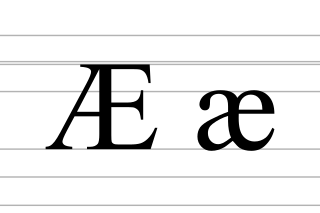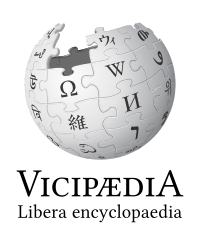
A diacritic is a glyph added to a letter or to a basic glyph. The term derives from the Ancient Greek διακριτικός, from διακρίνω. The word diacritic is a noun, though it is sometimes used in an attributive sense, whereas diacritical is only an adjective. Some diacritics, such as the acute ⟨á⟩, grave ⟨à⟩, and circumflex ⟨â⟩, are often called accents. Diacritics may appear above or below a letter or in some other position such as within the letter or between two letters.
Latin phonology is the system of sounds used in various kinds of Latin. This article largely deals with what features can be deduced for Classical Latin as it was spoken by the educated from the late Roman Republic to the early Empire. Evidence comes in the form of comments from Roman grammarians, common spelling mistakes, transcriptions into other languages, and the outcomes of various sounds in Romance.

Æ is a character formed from the letters a and e, originally a ligature representing the Latin diphthong ae. It has been promoted to the status of a letter in some languages, including Danish, Norwegian, Icelandic, and Faroese. It was also used in Old Swedish before being changed to ä. The modern International Phonetic Alphabet uses it to represent the near-open front unrounded vowel. Diacritic variants include Ǣ/ǣ, Ǽ/ǽ, Æ̀/æ̀, Æ̂/æ̂ and Æ̃/æ̃.
Ø is a letter used in the Danish, Norwegian, Faroese, and Southern Sámi languages. It is mostly used as to represent the mid front rounded vowels, such as and, except for Southern Sámi where it is used as an diphthong.

Ä is a character that represents either a letter from several extended Latin alphabets, or the letter A with an umlaut mark or diaeresis. In the International Phonetic Alphabet, it represents the open central unrounded vowel.

Œ is a Latin alphabet grapheme, a ligature of o and e. In medieval and early modern Latin, it was used in borrowings from Greek that originally contained the diphthong οι, and in a few non-Greek words. These usages continue in English and French. In French, the words that were borrowed from Latin and contained the Latin diphthong written as œ now generally have é or è; but œ is still used in some non-learned French words, representing open-mid front rounded vowels, such as œil ("eye") and sœur ("sister").

Ë, ë (e-diaeresis) is a letter in the Albanian, Kashubian, Emilian, Romagnol, Ladin, and Lenape alphabets. As a variant of the letter e, it also appears in Acehnese, Afrikaans, Belarusian, Breton, Dutch, English, Filipino, French, Luxembourgish, Piedmontese, Russian, the Abruzzese dialect of the Neapolitan language, and the Ascolano dialect. The letter is also used in Seneca, Taiwanese Hokkien, Turoyo, and Uyghur when written in Latin script.

Modern English is written with a Latin-script alphabet consisting of 26 letters, with each having both uppercase and lowercase forms. The word alphabet is a compound of alpha and beta, the names of the first two letters in the Greek alphabet. Old English was first written down using the Latin alphabet during the 7th century. During the centuries that followed, various letters entered or fell out of use. By the 16th century, the present set of 26 letters had largely stabilised:
In linguistics, vowel length is the perceived length of a vowel sound: the corresponding physical measurement is duration. In some languages vowel length is an important phonemic factor, meaning vowel length can change the meaning of the word, for example in Arabic, Estonian, Finnish, Fijian, Japanese, Kannada, Kyrgyz, Latin, Malayalam, Old English, Scottish Gaelic, Tamil and Vietnamese.
English rarely uses diacritics, which are symbols indicating the modification of a letter's sound when spoken. Most of the affected words are in terms imported from other languages. The two dots accent, the grave accent and the acute accent are the only diacritics native to Modern English, and their usage has tended to fall off except in certain publications and particular cases.
Romanization of Greek is the transliteration (letter-mapping) or transcription (sound-mapping) of text from the Greek alphabet into the Latin alphabet.
French orthography encompasses the spelling and punctuation of the French language. It is based on a combination of phonemic and historical principles. The spelling of words is largely based on the pronunciation of Old French c. 1100–1200 AD, and has stayed more or less the same since then, despite enormous changes to the pronunciation of the language in the intervening years. Even in the late 17th century, with the publication of the first French dictionary by the Académie française, there were attempts to reform French orthography.
Diacritical marks of two dots¨, placed side-by-side over or under a letter, are used in a number of languages for several different purposes. The most familiar to English-language speakers are the diaeresis and the umlaut, though there are numerous others. For example, in Albanian, ë represents a schwa. Such diacritics are also sometimes used for stylistic reasons.
Syllable stress of botanical names varies with the language spoken by the person using the botanical name. In English-speaking countries, the Botanical Latin places syllable stress for botanical names derived from ancient Greek and Latin broadly according to two systems, either the Reformed academic pronunciation, or the pronunciation developed initially in some large part by British gardeners, horticulturists, naturalists, and botanists of the 19th century. The two systems of pronunciation are sometimes referred to as the "classical method" and the "ecclesiastical method". The two systems differ significantly in pronunciation, but little in syllable stress.
Greek orthography has used a variety of diacritics starting in the Hellenistic period. The more complex polytonic orthography, which includes five diacritics, notates Ancient Greek phonology. The simpler monotonic orthography, introduced in 1982, corresponds to Modern Greek phonology, and requires only two diacritics.
The modern Corsican alphabet uses twenty-two basic letters taken from the Latin alphabet with some changes, plus some multigraphs. The pronunciations of the English, French, Italian or Latin forms of these letters are not a guide to their pronunciation in Corsican, which has its own pronunciation, often the same, but frequently not. As can be seen from the table below, two of the phonemic letters are represented as trigraphs, plus some other digraphs. Nearly all the letters are allophonic; that is, a phoneme of the language might have more than one pronunciation and be represented by more than one letter. The exact pronunciation depends mainly on word order and usage and is governed by a complex set of rules, variable to some degree by dialect. These have to be learned by the speaker of the language.
The traditional English pronunciation of Latin, and Classical Greek words borrowed through Latin, is the way the Latin language was traditionally pronounced by speakers of English until the early 20th century. Although this pronunciation is no longer taught in Latin classes, it is still broadly used in the fields of biology, law, and medicine.

The umlaut is the diacritical mark used to indicate in writing the result of the historical sound shift due to which former back vowels are now pronounced as front vowels.
French exhibits perhaps the most extensive phonetic changes of any of the Romance languages. Similar changes are seen in some of the northern Italian regional languages, such as Lombard or Ligurian. Most other Romance languages are significantly more conservative phonetically, with Spanish, Italian, and especially Sardinian showing the most conservatism, and Portuguese, Occitan, Catalan, and Romanian showing moderate conservatism.
The diaeresis is a diacritical mark used to indicate the separation of two distinct vowel letters in adjacent syllables when an instance of diaeresis occurs, so as to distinguish from a digraph or diphthong.










